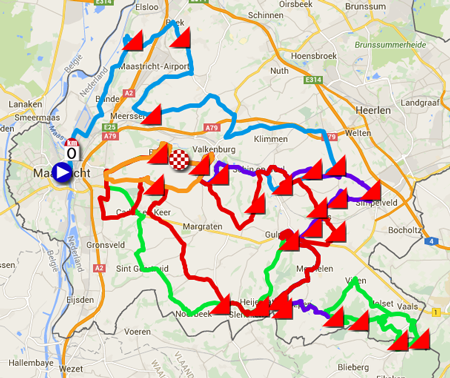This Sunday, the Dutch classic, the Amstel Gold Race, will take place between Maastricht and the Rijksweg in Vilt. Indeed, since 2013, the finish is no longer on top of the Cauberg in Valkenburg but at the same location as where the races of the 2012 cycling World Championships finished.
The race route of the Amstel Gold Race 2016 - which is the 51st edition - is a little bit different from last year's race route but the UCI WorldTour race still contains the same 34 climbs (in 2011 we went up from 31 climb to 32 and in 2012 back to 31, before going up to 34 in 2013). In this article you'll find the time- and route schedule and the race route on Google Maps. You can also download the race route in Google Earth for example to do a virtual fly-over of the race.
CONTINUE READING AFTER THIS ADVERTISEMENT
The description of the Amstel Gold Race 2016 race route
After the start on the Markt in Maastricht, the riders will first go north up to Geulle where they'll turn right and climb the Slingerberg which will rapidly be followed by the climbs of the Adsteeg and the Lange Raarberg.A bit further, when the riders approach the part of the race route they'll do several times, they'll climb the Bergseweg (just before the part which will be done several times) followed by the Sibbergrubbe, Cauberg and a first crossing of the finish line in Vilt (the blue part on the map of the race route).
The riders will get on the first loop around the finish, which will be 108.5 km long and which starts with the climb of the Geulhemmerberg followed by a part in northern direction towards the Belgian border, which they'll follow to get on the Wolfsberg and the Loorberg before they briefly go up north to get close to the Gulpenerberg without however getting on it's top, followed by another trip down south via the climb of the Schweibergerweg and another part along the border with the climb of Camerig, a small side trip towards Vijlen before they go on to the Drielandenpunt (a small climb where The Netherlands, Germany and Belgium come together), the climb of Gemmenich just on the other side of the Belgian border, and Vijlenerbos once they get back in The Netherlands. This part of the race route is drawn in green on the map.
The riders will climb the Eperheide in the purple part of the race route and, going up north over the same routes as before, they'll get off this route to climb the Gulpenerberg and the Plettenberg, Eyserweg, Sint Remigiusstraat, Vrakelberg and again the Sibbergrubbe followed by the Cauberg and the finish line which they'll cross for the 2nd time.
The 2nd loop around the finish, 67.7 kilometers long and drawn in red on the map, again starts with the climb of the Geulhemmerberg. After a side-trip south of Maastricht/Bemelen, the riders will turn right towards the climb of the Bemelerberg before going south towards the green loop where this time, after the Loorberg, they'll go straight and then left towards the Gulpenerberg followed by the Kruisberg (instead of turning on the Plettenberg like in the first loop), the Eyserbosweg and the Fromberg. The peloton turns left in Schin op Geul to get on the Keutenberg and goes on towards the third climb of the Cauberg which will this time be followed by a short loop (in orange) which is similar to the circuit of the 2012 cycling World Championships but which uses in this race the same circuit as in the previous loops and which thus contains the climb of the Geulhemmerberg in addition to the Bemelerberg.
The start will be at 10.15AM and the finish is planned to be around 4.34PM. The total distance will be 9.3 kilometers shorter than last year: 248.7 kilometers.
The time- and route schedule and the race route of the Amstel Gold Race 2016 on Google Maps
Hereunder you'll find the race route on Google Maps, the profile and the time- and route schedule (with the times the race will come by in the different cities and villages and on the different climbs) of the Amstel Gold Race 2016. Click on the images to open them.In order to make the map easier to "read", the race route is split up in five parts: the first part is blue, the second is green, the third is purple and the fourth one is red. The final circuit, 18.5 kilometers long, is shown in orange.



CONTINUE READING AFTER THIS ADVERTISEMENT
The Amstel Gold Race 2016 race route in Google Earth
Do you prefer to see the Amstel Gold Race 2016 race route in Google Earth and for example do a virtual fly-over of the race route? In order to do so, download the KML file below:>> Download the Amstel Gold Race 2016 race route in Google Earth

Vond u dit artikel interessant? Laat het uw vrienden op Facebook weten door op de buttons hieronder te klikken!
6 comments | 8750 views
this publication is published in: Classics | OpenStreetMap/Google Maps/Google Earth





 by thcman over
by thcman over
Hi
......my download in Google earth is OK, but I don't know how to do 'a fly-over'
Hello Martin,
Sorry for the late reply :(.
In Google Earth you can select the path (the three dots connected by lines) and click the play button on the right to do a "fly-over" :).
Le triptyque ardennais commence et quel choc pour les suiveurs après les flandriennes, on a assisté une fois de plus à une course cadenasser où les trop rares offensives sont vouées à l'échec, cela ressemble a un pauvre match de L1 en novembre/décembre entre 2 équipes frileuses satisfaite de prendre 1 point sans rien proposer.
Que faire pour redonner à ces courses un minimum d'intérêt ?
Thomas, les néerlandais sont t'ils aussi dépités que moi devant le triste spectacle d'hier et de ces dernières années ?
Effectivement, cet amstel ne restera pas dans les annales, tout comme le triste spectacle que l'on a eu hier sur la flèche avec une course de côte sur trois cent mètres...et liège arrive à dimanche. J'anticipe la présentation de cette course pour faire part de ma nouvelle déception quant au tracé proposé par aso sur liège,
le stockeu est impraticable cette année , soit cela arrive, mais au lieu de repenser la philosophie du parcours, aso nous rajoute une côte inutile après saint nicolas, cela fait maintenant trois côtes dans les 5 derniers km, autrement dit aso renforce le blocage de la course et l'attitude attentiste des coureurs......la redoute sera donc encore escamoté, peut être en plus la roche aux faucons, pendant ce temps la des côtes historiques comme le mur des hézalles sont toujours oubliés, la côte de lorcé et la vécquée ont aussi disparu....la côte de chambralles est aux oubliettes....bref conformisme et attentisme semble être les maitres mots d'aso pour liège, quel dommage !
Bonjour Maziro.
L'Amstel Gold Race :
Sportivement, cette course n'a pas sa place aux cotés des grands monuments.
Les organisateurs multiplient les tourniquets, mais c'est un foutoir.
J'ajoute, hors sujet, que je préférais le Tour des Flandres à l'ancienne avec Grammont en juge de paix ...
La Flèche Wallonne :
Quel gachis de voir ce qui fut jadis une grande classique de 250-270 km ravalée à moins de 200 km avec le Mur de Huy en points fixes.
Faut arreter et revoir toute la copie.
Le maintien du Mur comme arrivée (mais sans passage préalable) ne me dérange pas à condition de ne pas avoir d'autres arrivées en cote pour les classiques de printemps.
Liège-Bastogne-Liège :
Primo : comment ne pas etre d'accord avec vous et un certain Eddy Merckx pour une revalorisation du secteur autour de Stavelot sur la Doyenne ?
Secondo : revenons à une arrivée centre-ville après une courte descente.
Ce n'est pas Liège-Bastogne-Ans !
Tertio : y a trop de km entre laRoche-aux-Faucons et le pied de Saint-Nicolas.
Mais pourquoi se borner à un enchainement direct via l'"autoroute" Boncelles-Standard ?
Ne serait-il pas plus intéressant de piquer vers Seraing par le bois et une descente sinueuse, le long de la Meuse reprendre à droite vers les hauteurs d'Ougrée (commune construite en escalier sur le balcon sud du fleuve) avant de rejoindre le stade Dufrasne.
Quelques kilomètres en plus (on s'en fout), mais beaucoup moins de temps morts.
Ciao.
André je ne peux qu'approuver votre analyse, il me semble qu'ASO ne produit pas la bonne analyse sur liège bastogne liège, ce qui explique ces choix de parcours douteux, l'histoire et la légende de liège c'est une course d'usure avec un parcours qui présente une dizaine de côte et une arrivée, en plaine c'est cette philosophie de tracé qui m'a enchanté dans les années 80 avec les duels criquélion, argentin,roche etc.....un schéma simple avec la zone de stavelot en point central (hézalles,aisomont ou wanne, stockeu, haute levée) des côtes d'usure (lorcé, vécqué) et un final avec la redoute en juge de paix, et les forges en dernière côte à 15 km de l'arrivée, montée peu sélective qui obligeait à utiliser la redoute comme marche pied final......
Mais ASO a repris cette course en 1990 et progressivement, leblanc puis prudhomme on changé la fin du parcours, introduction de la côte d'ans comem arrivée en 1992, saint nicolas en 1999 (je crois), la roche aux faucons en 2008, et cet côte sans intérêt cette anné....
En parallèlle, la course est devenur de plus aseptisé à mesure qu'aso durcissait le final et allégeait la zone autour de stavelot,les dernières batailles sur la redoute avec jalabert,bartoli, et zuelle se sont achevées à la fin des années 90, et l'introduction de saint nicolas; aujourd'hui la redoute ne sert plus à rien, quelle tristesse...pourtant c'est avec stoockeu la côte de légende de liège....
ASO a succombé progressivement aix sirènes du modernisme et de la mode des fin de parcours musclés, c'est une erreur d'autant plus inexplicable pour moi car on sais que prudhomme connait parfaitement l'histoire du cyclisme, et sur paris roubaix il arrive à garder un parcours vintage, donc c'est une question de choix...il n'y a pas de fatalité....
Le contrat d'arrivée avec la ville d'ans s'achève bientôt, c'est une occasion pour aso de tenter un pacours vintage pour l'une des prochaines éditions, retour à lège centre, disparition de la côtes de saint nicolas....réintroduction de côtes autour de stavelot...et un final avec la redoute en juge de paix (en 1991 le sommet de la redoute avait été placé à 26km de l'arrivée à liège centre..) et
derrière les forges (sommet à 14 km de l'arrivée)...peut être que cela ne marchera pas, peut être qu'il y aura 60 coureurs et un sprint massif à liège, mais au moins liège aura renoué avec son parcours historique,......cela vaut le cous d'essayer au moins une fois.....